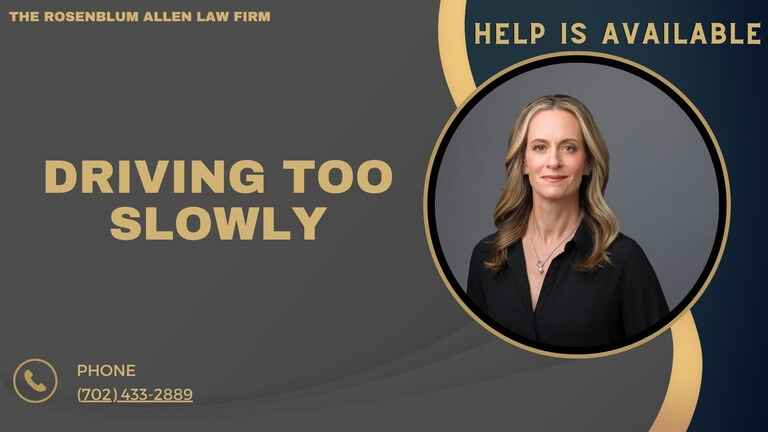Many drivers focus on avoiding speeding. But did you know that driving too slowly can also lead to problems on the road? Going below a safe or expected speed can disrupt traffic, create safety hazards, and, in some cases, even result in fines or other legal penalties.
Maintaining an appropriate speed is essential. Driving too slowly doesn’t just frustrate other drivers—it can be dangerous. In this article, we’ll explore the reasons people drive too slowly, the legal issues that come with it, and practical steps to avoid this habit.

What Constitutes Driving Too Slowly?
Definition of Driving Too Slowly
Driving too slowly generally refers to traveling at a speed far below the posted limit or the flow of traffic in a way that disrupts other vehicles. But it isn’t always as simple as going under the speed limit. Some areas don’t even have minimum speed signs, leaving it up to drivers to judge.
Key Points That Define Slow Driving:
- Moving much slower than surrounding traffic on highways or freeways.
- Causing others to swerve, brake suddenly, or become frustrated.
- Driving slower than what’s safe under the conditions (like clear weather and open roads).
Legal Standards and Minimum Speed Limits
Most areas have minimum speed limits, especially on highways, to prevent accidents from slow driving. This doesn’t mean everyone has to drive at least the minimum speed in every condition, but it helps to understand when slow driving can lead to a ticket.
Minimum Speed Guidelines Based on Road Type:
| Road Type | Typical Minimum Speed (mph) | Examples |
|---|---|---|
| Highways/Freeways | 40–50 | Major interstate highways |
| City Streets | 20–30 | Busy city or suburban streets |
| Residential Areas | Often No Minimum | Neighborhoods with children or pets |
| School Zones | Often No Minimum | Areas marked by school signs/lights |
Local laws vary, so it’s essential to know the specific rules in your area.
Driving Too Slowly Versus Obstruction of Traffic
Driving too slowly isn’t just about moving under a certain speed. Sometimes, it’s about how your driving affects others. When slow driving causes a line of cars behind you or forces others to pass unsafely, it can be considered obstructing traffic.
Key Differences:
- Slow Driving: Refers to the act of moving below the posted limit.
- Traffic Obstruction: Refers to slow driving that creates hazards or delays.
Examples of obstructing traffic:
- Driving 10 mph under the limit on a single-lane road with no passing opportunities.
- Holding up traffic on a highway in the left lane, which is typically reserved for faster-moving vehicles.
Common Causes of Driving Too Slowly
Inexperienced or Cautious Drivers
One of the most common reasons for slow driving is lack of experience. New drivers or those who feel nervous behind the wheel may hesitate to reach normal speeds. They might feel safer going slowly, especially in high-traffic areas or unfamiliar routes.
Other cautious drivers include:
- Elderly drivers: Some older adults may drive cautiously due to slower reaction times or vision challenges.
- Teen drivers: Young drivers, still adjusting to the road, might feel unsure about matching the speed of other vehicles.
Road and Weather Conditions
In bad weather, reducing speed is often wise. However, there’s a fine line between being careful and driving so slowly that it becomes hazardous for others.
Common Weather Scenarios:
- Rain or Wet Roads: Slower speeds help with traction but should still be reasonable to avoid disrupting traffic.
- Fog: It’s natural to slow down in low visibility, but it’s also important to stay close to a safe, predictable speed.
- Snow or Ice: Going slower than usual is necessary on icy roads, but extremely slow driving may make it difficult for other vehicles to adjust.
When these conditions aren’t present, driving below the speed limit can lead to frustration and unsafe road situations for other drivers.
Vehicle Issues and Mechanical Problems
Mechanical issues can also lead to slow driving. If a car is struggling to accelerate or maintain speed, the driver may go slower than usual to prevent damage.
Common Mechanical Problems Leading to Slow Driving:
- Transmission issues: Gear problems can prevent the car from reaching higher speeds.
- Low tire pressure or worn tires: These can impact a car’s ability to grip the road, especially in wet conditions.
- Engine overheating: Drivers may slow down to avoid worsening the problem.
In these situations, it’s safer for drivers to pull over and address the issue rather than continue to drive too slowly on the road.
Distractions and Health Issues
Distractions or health concerns can also cause a driver to slow down. If a driver feels unwell or distracted, they may unconsciously reduce their speed.
Common Distractions That Cause Slow Driving:
- Cell phone use: Texting or making calls can reduce reaction time, leading to slower speeds.
- GPS or navigation adjustments: Drivers might slow down to check directions or re-route.
- Eating or drinking: These actions can divert focus from the road.
Health Issues That May Impact Driving Speed:
- Vision problems: Drivers with poor night vision might drive slowly after dark.
- Reaction time issues: Older drivers or those with certain medical conditions may drive slower for better control.
If a driver is not feeling well, it’s better to pull over rather than risk driving too slowly and endangering others.

Potential Consequences of Driving Too Slowly
Traffic Accidents and Safety Risks
Driving too slowly might seem safer, but it can actually increase the chances of accidents. When drivers go significantly below the speed limit, it disrupts the natural flow of traffic, which can lead to rear-end collisions or other dangerous situations. Other drivers might try to pass suddenly, creating risks for everyone on the road.
Risks of Slow Driving:
- Rear-end collisions: Faster vehicles may not expect a slower car and may be unable to stop in time.
- Impatient drivers: Others may attempt risky maneuvers to overtake a slow-moving vehicle.
- Confusion for other drivers: Slow driving can confuse drivers about the appropriate speed and cause unexpected braking or swerving.
Although slower speeds can sometimes feel safer, there’s a balance. Going too slowly can create obstacles, making it hard for other drivers to react quickly or safely.
Traffic Violations and Fines
In many areas, driving too slowly is not just a safety issue—it’s also against the law. Most states have laws about obstructing traffic or driving at unreasonable speeds. If a driver is holding up traffic, police officers can issue a ticket, even if the driver is going below the speed limit.
Common Reasons for Slow-Driving Tickets:
- Ignoring minimum speed limits: Many highways require drivers to keep up with a minimum speed to maintain the flow of traffic.
- Causing congestion: If a driver is moving so slowly that it leads to traffic buildup, they may be cited.
- Staying in the left lane: Many states have “keep right” laws, meaning slower drivers should stay in the right lane to let faster traffic pass on the left.
Fines for driving too slowly can vary, but they serve as a reminder that keeping a safe, steady speed is essential for everyone on the road.
Legal Implications of Driving Too Slowly
State-by-State Differences in Traffic Laws
Traffic laws related to slow driving can vary by state. Some states have strict minimum speed requirements on highways and certain roads. Others have more flexible guidelines but still encourage drivers to keep up with traffic.
Examples of State-Specific Laws on Slow Driving:
| State | Key Slow-Driving Rules | Consequence |
|---|---|---|
| California | Requires drivers to move out of the left lane if impeding flow | Fine for obstructing traffic |
| Texas | Has minimum speed signs on highways | Fines and potential license points |
| Florida | Allows ticketing for impeding traffic flow | Moving violation ticket |
| New York | Requires slow drivers to stay in the right lane | Fine or potential court appearance |
Understanding the rules in each state is essential, especially for those who travel between states or frequently use major highways. Not all states have the same approach, so knowing the differences can help drivers avoid unwanted fines.
Exceptions to Slow Driving Restrictions
In some situations, driving more slowly is acceptable and even encouraged. Safety is the priority, so there are exceptions to rules about minimum speed. For example, if weather conditions are severe, going slower is expected to reduce risks.
Situations Where Slower Driving is Allowed:
- Heavy rain or snow: Reduced speeds are encouraged when visibility and road traction are poor.
- Fog or smoke: In low-visibility situations, driving slowly helps reduce accident risks.
- Accidents or road hazards: Drivers are allowed to slow down to navigate around broken-down vehicles, construction zones, or other obstacles.
Drivers who need to go below the usual speed for legitimate reasons are generally protected from penalties. However, it’s always a good idea to use hazard lights to signal other drivers if the speed difference is significant.

How to Avoid Driving Too Slowly
Techniques for Maintaining a Safe and Appropriate Speed
If you’re worried about driving too slowly, there are simple ways to help maintain a safe and steady speed. For drivers who may feel anxious, especially in high-traffic areas or on highways, building confidence behind the wheel can make a big difference.
Practical Tips to Avoid Slow Driving:
- Use cruise control (if your vehicle has it) to stay close to the speed limit on highways.
- Practice driving in familiar areas before venturing onto busy highways or unfamiliar routes.
- Check your speedometer often, especially on roads without posted minimum speeds, to ensure you’re keeping pace with other drivers.
- Follow traffic flow: Keeping an eye on other vehicles can help you match the overall speed without exceeding limits.
- Take defensive driving courses: These can help improve confidence and teach skills for maintaining a safe speed in various conditions.
Even drivers who feel anxious or prefer a slower pace can find ways to improve their driving experience and avoid going too slowly.
Using Technology to Help Regulate Speed
Technology can be a helpful tool for staying at a safe speed. Many modern vehicles come with features that help drivers stay aware of their speed and adjust to changing conditions on the road.
Helpful Vehicle Technologies:
- Speed alerts: Some cars allow drivers to set speed alerts, which notify them if they are driving too slowly or too quickly.
- Adaptive cruise control: This feature adjusts your speed based on the traffic around you, making it easier to stay within a safe range.
- Lane assist: By helping drivers stay centered, lane assist can make it easier to maintain a steady speed without unintentional drifting or slowing down.
Drivers who struggle with speed control can look for these features when purchasing a new vehicle or check if their current car has these capabilities.

Breaking It Down for You
Driving too slowly might seem like a safer option, but it can create hazards, disrupt traffic flow, and even lead to fines. Keeping an appropriate speed helps traffic move more smoothly and ensures everyone gets to their destination safely. By understanding the laws in your state, maintaining a consistent pace, and using technology like adaptive cruise control, you can avoid the potential issues of slow driving.
It’s not just about avoiding tickets—driving at a safe and steady speed benefits everyone on the road. Whether it’s adhering to minimum speed limits or staying out of the left lane if you’re driving at a slower pace, taking small actions can have a significant impact. Safe driving involves finding the right balance between speed and safety, helping you protect both yourself and others every time you drive.

Frequently Asked Questions
What is the minimum speed limit on highways?
Minimum speed limits on highways can vary depending on the state and specific road conditions. Generally, these limits are posted on signs along highways. The goal is to maintain a safe flow of traffic. If no minimum speed limit is posted, drivers are expected to drive at a reasonable speed given the conditions.
Can I get a ticket for driving too slowly in the left lane?
Yes, in many states, driving too slowly in the left lane (often called the passing lane) is considered illegal. The left lane is meant for faster-moving traffic, and drivers should only use it to pass slower vehicles. If you are driving at a slower speed and not passing anyone, you could be ticketed for impeding traffic.
How slow is too slow when driving?
While this depends on road conditions, it’s generally considered too slow if you are driving significantly under the posted speed limit or not maintaining a speed that is safe for the flow of traffic. In some cases, driving under the speed limit can be considered obstructing traffic and lead to fines.
What should I do if I see someone driving too slowly?
If you encounter a driver going too slowly, the best course of action is to stay patient and keep a safe distance. If possible, safely pass them when it is legal to do so. In some cases, it may be a good idea to report the driver to the authorities if they are causing a dangerous driving situation.
Are there any exceptions to driving at the posted speed limits?
Yes, there are certain situations where driving at or near the posted speed limit may not be safe. Weather conditions, roadwork, heavy traffic, and other factors can warrant driving slower than the posted limit. Always adjust your speed to match road conditions, even if it means going slower than the posted speed limit.
Does driving too slowly cause accidents?
Yes, driving too slowly can increase the risk of accidents, especially on high-speed roads. It can confuse other drivers and create sudden changes in traffic flow. In some cases, slow drivers can even cause rear-end collisions when other drivers don’t anticipate their reduced speed. It’s essential to maintain a speed that matches traffic flow for everyone’s safety.
How can technology help prevent driving too slowly?
Modern vehicles come equipped with features such as adaptive cruise control, which can help maintain a safe, steady speed while driving. These technologies can automatically adjust the car’s speed to match the flow of traffic, reducing the chances of driving too slowly without realizing it.
What are the penalties for driving too slowly?
Penalties for driving too slowly can include fines, points on your driving record, or even a traffic citation for impeding the flow of traffic. In some areas, slow driving may be treated as a moving violation. The severity of the penalty depends on local laws and the circumstances of the situation.
Can driving too slowly be a sign of a medical condition?
In some cases, yes. If a driver is constantly going much slower than the flow of traffic or seems unable to maintain a safe speed, it could be due to a medical condition such as vision impairment or a cognitive issue. If you or someone you know is exhibiting these behaviors, it’s important to consult a healthcare provider to ensure they are fit to drive.
What is the difference between driving too slowly and driving cautiously?
Driving cautiously means being aware of the road and adjusting your speed based on conditions like weather, traffic, or visibility. Driving too slowly, on the other hand, often means driving at a speed that is not appropriate for the road, causing disruptions and creating hazards for other drivers.

Glossary
Adaptive Cruise Control – A technology that automatically adjusts a vehicle’s speed to maintain a safe distance from the car ahead. It helps maintain a consistent speed and can reduce the risk of driving too slowly or too fast.
Left Lane – The lane on a multi-lane road or highway typically used for overtaking other vehicles. In many places, it’s illegal to drive too slowly in this lane as it can impede traffic.
Minimum Speed Limit – The lowest speed allowed to be driven on a particular road or highway, typically posted on signs. Driving below this speed can result in penalties.
Obstructing Traffic – When a vehicle is moving at a speed that is significantly slower than the flow of traffic, making it difficult or unsafe for other vehicles to pass or maintain normal speed.
Posted Speed Limit – The maximum (or sometimes minimum) speed that drivers are legally allowed to travel on a particular road. This limit is typically marked with signs along the route.
Rear-End Collision – A type of car accident where one vehicle crashes into the back of another vehicle, often caused by sudden or unexpected changes in speed or traffic flow.
Traffic Citation – A written notice issued by law enforcement for violating a traffic law, such as driving too slowly or obstructing traffic. A citation often comes with a fine or other penalty.
Traffic Flow – The movement of vehicles on a road or highway. Maintaining a consistent and safe speed helps ensure that traffic flows smoothly without disruptions or delays.
Vehicle Impairment – A condition where a driver’s ability to operate a vehicle safely is affected, which could include medical conditions, mental states, or external factors like alcohol or drugs.
Vision Impairment – A medical condition where an individual’s ability to see clearly is reduced, potentially affecting their driving ability and decision-making on the road.
Moving Violation – A violation of traffic laws that occurs while a vehicle is in motion, such as speeding, running a red light, or driving too slowly. These violations often result in fines and points on the driver’s record.
Speed Adjustment – The process of changing a vehicle’s speed to match road conditions, such as slowing down during heavy traffic or bad weather.
Steady Pace – Maintaining a consistent and appropriate speed that matches the flow of traffic, which helps prevent causing disruptions or creating potential hazards on the road.

Additional Resources for You
Our lead attorney, Molly Rosenblum, Esq, has created several resources to assist you in your time of need. Below you will find a list of these resources:
- Nevada Traffic Tickets: Information and guidance on how to handle traffic tickets in Nevada.
- Warrant Defense Attorneys: Get professional help if you’re facing a warrant.
- Do You Need to Hire a Lawyer for Misdemeanor Charges?: Understand when it’s necessary to hire a lawyer for misdemeanor charges.
- The Nevada Arraignment – Frequently Asked Questions: Have your questions about Nevada arraignment procedures answered.
- The Definitive Guide to Sealing Criminal Records in Nevada: Learn how to seal your criminal records in Nevada.
- Sex Crime Defense Attorneys: Get the defense you need for sex crime charges.
- Nevada Shoplifting Laws: Understand the laws and penalties for shoplifting in Nevada.
- Gang Crimes Lawyer: Receive legal support if you’re charged with gang-related crimes.
- Murder vs Homicide: Learn the differences between murder and homicide charges.
- Extortion: Understand the legal implications of extortion charges.
- First Time DUI: Understand what happens when you’re charged with a DUI for the first time.
- Second Time DUI: Learn about the consequences of a second DUI charge.
- Third Time DUI: Find out the implications of a third DUI charge.
Please note that while these resources provide valuable information, they are not a replacement for legal advice. Always consult with a professional for your specific situation.

A Special Message from Our Lead Attorney

Molly Rosenblum
Dear Reader,
Thanks for reviewing the helpful information we’ve provided about fighting traffic tickets in Nevada.
I hope you now feel better equipped to contest that unjust citation. Don’t let it go unchallenged!
My team and I have decades of experience successfully getting charges reduced or dismissed for drivers like you.
We know how to carefully examine the allegations, identify technical flaws, leverage expert testimony, and build an aggressive defense.
If you are ready to start fighting that ticket, please don’t hesitate to call me at (702) 433-2889.
We offer affordable rates and convenient payment plans. I look forward to helping protect your driving record.
Reach out to us today.
Let’s start building your defense strategy against that unfair traffic ticket today!
Best Regards,
Molly Rosenblum, Esq.


